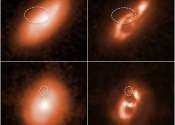How did the Butterfly Nebula get its wings? It's complicated
Planetary nebulae form when red giant stars expel their outermost layers as they run out of helium fuel—becoming hot, dense white dwarf stars that are roughly the size of Earth. The material that was shed, enriched in carbon, ...









